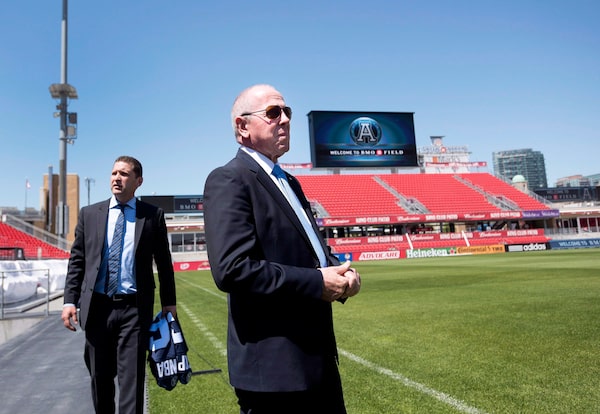
Larry Tanenbaum walks on to BMO Field following a press conference in Toronto on May 20, 2015.Darren Calabrese/The Canadian Press
Maple Leaf Sports & Entertainment makes a boatload of money, but it is short on glamour.
Were you to rock up to the bar at St. Tropez and tell the person next to you that you own the Toronto Maple Leafs, they might think you were in forestry. The Raptors might make more of an impression, though not lately. Everything else in the MLSE stable, forget it.
More than business, this explains MLSE principal Larry Tanenbaum’s interest in AS Saint-Étienne.
A formerly great soccer club that was the inspiration for a pretty good band, Saint-Étienne is the sort of sports team whose name resonates from Tokyo to Tangiers. The person who owns this club isn’t at the centre of global sport, but they are in the game.
This week, the club announced they are in exclusive negotiations with Tanenbaum’s Kilmer Group about a sale, and expect to wrap up business within a few weeks.
“AS Saint-Étienne is more than just a football club. It’s a community,” Tanenbaum said in a statement.
A year ago, could Tanenbaum have pointed out the city of Saint-Étienne on an unmarked map? It doesn’t matter. He’ll roll into town juggling baguettes if someone tells him to.
While his relationship with his corporate partners in MLSE wobbles, Tanenbaum’s parallel sports empire is booming. He’s about to close business on a WNBA franchise, and now this.
The WNBA club makes fiscal sense. You’re getting in on a growing concern.
Faded football teams are like medieval castles – you know you’ll never be able to fix it, or live in it, or make money off it, but you still can’t resist.
Of late, France’s Ligue 1 has become a proving ground of ambitious billionaires. The sort who would like to own a club in England, but can’t convince anyone to sell to them, or one in Italy, but aren’t delusional enough to believe that would be anything but a disaster.
Ligue 1 is the Goldilocks option. Biggish, but not big. Competitive, but not cutthroat. It’s for people who made their money the boring way and want to make a later-in-life turn into high society.
After making his fortune in petrochemicals, Ligue 1 was where British billionaire Jim Ratcliffe went to launch his sporting empire. A couple of years spent not running OGC Nice into the ground proved he was ready to take on real responsibility. Now Ratcliffe is part owner of Manchester United, which he is currently running into the ground.
Tanenbaum tried this the wrong way around, launching a failed bid for Chelsea Football Club. He’s since gotten hip to the way things work in Europe.
First problem – Tanenbaum isn’t buying into Ligue 1. Saint-Étienne was demoted to the second division a couple of years ago and is bleeding money while it tries to scrabble back to the top.
Tanenbaum may not be familiar with the country, but he will understand the culture. Saint-Étienne is the Maple Leafs of French soccer – its glory days were exceedingly glorious, and a long time ago.
This is the club that featured Michel Platini, the great French player of the 20th century. It won 10 domestic titles and played in the final of a European Cup. But that was more than 40 years ago. Since then, Saint-Étienne has yo-yo’d from contender to pretender, never quite managing to matter.
Their problem is the same one shared by all mediocre soccer teams – cash.
These days, it looks simple. You buy a crummy football club, hire a cameraman, pitch it to Netflix and boom – everything works out.
Ryan Reynolds is already reaching the limits of this feel-good story with his hobby team, Wrexham. The Welsh club has been promoted in two successive seasons. Now it gets tough. While Wrexham’s players were on a celebratory tour through the United States recently, a whack of the team found out it had been let go.
The Premier League is two more jumps up the ladder. Many of those who brought them this far are now dead weight. To this point, Wrexham has been an affordable vice. If Reynolds and his partners want to go further, they will have to start burning real money.
This is the challenge that faces Tanenbaum. For decades, Saint-Étienne has been under the tumultuous stewardship of a series of French businessmen. They weren’t much good, but they did speak the language.
When fans of a venerable European club see a foreigner on the horizon, they think one thing – ‘I’m sure this rube will bankrupt himself trying to give us what we want.’ They’re not sure which coast Toronto is on (trick question), but they’re hoping that whichever it is, they grow them stupid out there.
There are no salary caps to fig leaf a soccer owner’s drive for profit. If Tanenbaum refuses to spend wildly, he should expect some blowback.
But maybe that’s what he wants to do. And why not?
It is not hard to see Tanenbaum’s grand plan – make Toronto as big and brassy a sports capital as New York or Los Angeles. To do that, you need something more than titles. You need dynasties.
Unlike his partners in MLSE, Tanenbaum, 79, is a fan of his clubs. When they lose, you will see him morosely stalking the halls backstage.
Ten years ago, he must have thought his sports fantasies would be realized. Everything peaked in 2019 when the Raptors won. Since then, it has been dissolution across the board, edging toward chaos. The short term is not bright, neither for MLSE nor his involvement in it.
Saint-Étienne gives Tanenbaum a shot at making himself a truly global player. Unlike the WNBA, he doesn’t have to build anything. It’s already built. All that’s required is the willingness to blow through every nickel he’s ever earned.